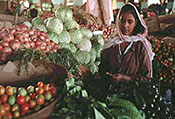Agricultural marketing in India
Anirban
Biswas
13 July 2004
In this last of our three part series on Indian agriculture, here we discuss how agricultural marketing taking place in Indian economy agriculture is burning issue of the days.
 India is an agricultural country and one third population depends on the agricultural sector directly or indirectly. Agriculture remains as the main stray of the Indian economy since times immemorial. Indian agriculture contribution to the national gross domestic product (GDP) is about 25 per cent. With food being the crowning need of mankind, much emphasis has been on commercialising agricultural production. For this reason, adequate production and even distribution of food has of late become a high priority global concern.
India is an agricultural country and one third population depends on the agricultural sector directly or indirectly. Agriculture remains as the main stray of the Indian economy since times immemorial. Indian agriculture contribution to the national gross domestic product (GDP) is about 25 per cent. With food being the crowning need of mankind, much emphasis has been on commercialising agricultural production. For this reason, adequate production and even distribution of food has of late become a high priority global concern.
Agricultural marketing is mainly the buying and selling of agricultural products. In earlier days when the village economy was more or less self-sufficient the marketing of agricultural products presented no difficulty as the farmer sold his produce to the consumer on a cash or barter basis.
Today's agricultural marketing has to undergo a series of exchanges or transfers from one person to another before it reaches the consumer. There are three marketing functions involved in this, i.e., assembling, preparation for consumption and distribution. Selling on any agricultural produce depends on some couple of factors like the demand of the product at that time, availability of storage etc. The products may be sold directly in the market or it may be stored locally for the time being. Moreover, it may be sold as it is gathered from the field or it may be cleaned, graded and processed by the farmer or the merchant of the village. Sometime processing is done because consumers want it, or sometimes to conserve the quality of that product. The task of distribution system is to match the supply with the existing demand by whole selling and retailing in various points of different markets like primary, secondary or terminal markets.
Most of the agricultural products in India are sold by farmers in the private sector to moneylenders (to whom the farmer may be indebted) or to village traders. Products are sold in various ways. For example, it might be sold at a weekly village market in the farmer's village or in a neighboring village. If these outlets are not available, then produce might be sold at irregularly held markets in a nearby village or town, or in the mandi.
In India, there are several central government organisations, who are involved in agricultural marketing like, Commission of Agricultural Costs and Prices, Food Corporation of India, Cotton Corporation of India, Jute Corporation of India, etc. There are also specialised marketing bodies for rubber, tea, coffee, tobacco, spices and vegetables.
